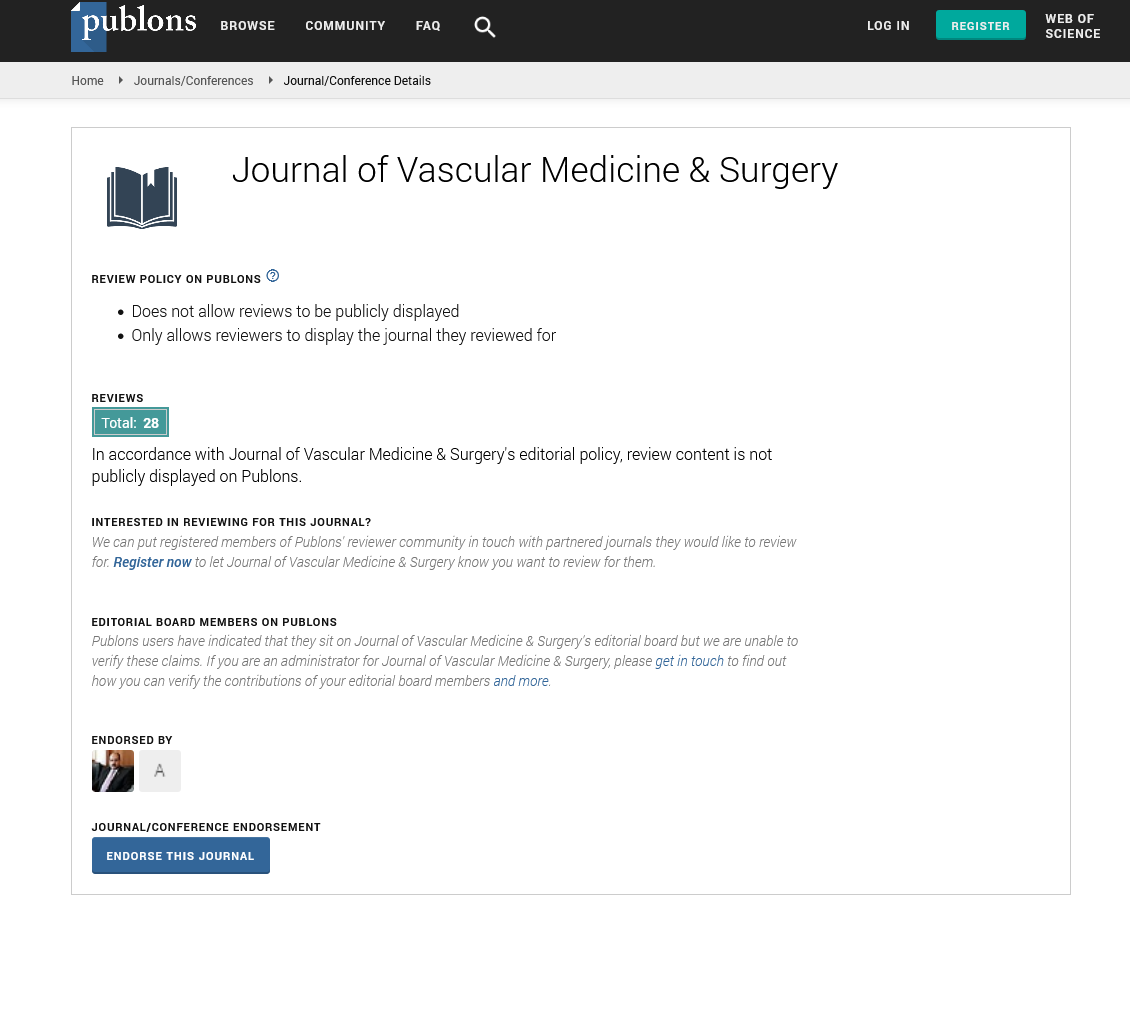Indexed In
- Open J Gate
- Academic Keys
- RefSeek
- Hamdard University
- EBSCO A-Z
- OCLC- WorldCat
- Publons
- Euro Pub
- Google Scholar
- SHERPA ROMEO
Useful Links
Share This Page
Journal Flyer

Open Access Journals
- Agri and Aquaculture
- Biochemistry
- Bioinformatics & Systems Biology
- Business & Management
- Chemistry
- Clinical Sciences
- Engineering
- Food & Nutrition
- General Science
- Genetics & Molecular Biology
- Immunology & Microbiology
- Medical Sciences
- Neuroscience & Psychology
- Nursing & Health Care
- Pharmaceutical Sciences
Opinion Article - (2023) Volume 11, Issue 6
The Indications of a Tubercular Coronary Blood Vessel on CT Diagnostic Imaging
Horn Mathew*Received: 27-Oct-2023, Manuscript No. JVMS-23-24126; Editor assigned: 30-Oct-2023, Pre QC No. JVMS-23-24126 (PQ); Reviewed: 15-Nov-2023, QC No. JVMS-23-24126; Revised: 22-Nov-2023, Manuscript No. JVMS-23-24126 (R); Published: 29-Nov-2023, DOI: 10.35248/2329-6925.23.11.542
Description
The vascular wall becomes infected and is destroyed, resulting in the formation of a mushroom-shaped structure on the blood vessel known as a Mycotic Aortic Aneurysm (MAA). An acute inflammatory reaction to a pathogenic infection is known as MAA. The most frequently reported pathogens are Staphylococcus and Salmonella; other pathogenic species include Treponema pallidum, Mycobacterium tuberculosis, Streptococcus pneumoniae, and human immunodeficiency virus. Tubercular Aortic Aneurysm (TBAA) represents 0.3% of all aneurysms and is extremely rare. Because of its high risk of abrupt rupture, TBAA is linked to a high death rate. Prior to the development of combined technologies for contemporary imaging, anti-TB therapy, and surgical treatment, no patients with TBAA were known to have survived. Prompt diagnosis and treatment are important factors in increasing survival. However, the lack of specific symptoms and negative blood cultures make an early diagnosis challenging. Certain cases are detected at a later stage or following the emergence of complications like aortic fistula or rupture. When a patient is clinically suspicious, current imaging modalities such as Computed Tomography (CT), Magnetic Resonance Imaging (MRI), and 18F-Fluorodeoxyglucose (FDG) Positron Emission Tomography (PET)/CT can identify infected aneurysms.
The entire aorta can be evaluated using CT angiography combined with imaging of the arterial and venous phases. CTA is being utilized more often in the diagnostic evaluation of aortic disease, including TBAA, due to its non-invasiveness, effectiveness, wide coverage, and isotropic voxel capabilities. The main findings on CT are as follows: TBAA is primarily a single saccular, lobulated pseudo aneurysm that usually affects the abdominal and thoracic aortas. Extravascular tuberculosis is typically present in forms such as psoas abscess, iliopsoas abscess, lymph node tuberculosis, and miliary pulmonary tuberculosis. Even though mycotic aortic aneurysm is a rare complication of tuberculosis, its mortality rate is extremely high. Future increases in immune deficient patient populations and the emergence of drug-resistant tuberculosis could lead to an increase in incidence. Suspicion of TBAA should arise when mycotic aneurysms are found in the context of tuberculosis, especially in cases of disseminated tuberculosis. In all of our cases, the diagnosis at the time of presentation was active tuberculosis of any kind. Patients with pulmonary tuberculosis had positive sputum tuberculosis tests. All of the patients in this group had elevated CRP and ESR concentrations despite negative blood cultures. A small number of patients had underlying medical conditions such as HIV infection, rheumatic diseases, or use of oral immune suppressants that were known to raise the risk of tuberculosis. Diabetes is also associated with an increased risk of tuberculosis. Five of the patients in this group had a history of diabetes, and one patient had HIV. The majority of TBAA cases that have been documented have symptoms, however these symptoms are not always clear-cut and vary depending on the aneurysm's size, location, and rate of growth. Individuals may report dorsal, abdominal, or thoracic pain. Fever may accompany certain patients. Fever has been reported to strike 35% of patients. With 7 patients (41.2%) in this group, the proportion of fever is comparatively high.
Anti-tuberculosis chemotherapy, open surgery (extra-anatomic bypass or in situ reconstruction), and endovascular therapy (stent grafting, embolization) are the treatment options for Tuberculosis-Associated Acute Amnesia (TBAA). In this group, the mortality rate from tubercular aneurysm is still quite high at 35 percent. The mortality of TBAA can be decreased in large part by receiving treatment promptly after diagnosis. CT is crucial to the TBAA diagnosis process. On CT scan, tuberculous aneurysms appear as poured and unstressed due to a greater number of cysts and lobulated shapes compared to other infectious aneurysms. Another aspect of differential diagnosis is that tubercular aneurysms' surrounding tissues and neighboring organs are frequently infected with tuberculosis, and the majority of these infections are accompanied by additional tuberculosis sites. For diagnosis, routine CT follow-up is also crucial.
Citation: Mathew H (2023) The Indications of a Tubercular Coronary Blood Vessel on CT Diagnostic Imaging. J Vasc Surg. 11:542.
Copyright: © 2023 Mathew H. This is an open access article distributed under the terms of the Creative Commons Attribution License, which permits unrestricted use, distribution, and reproduction in any medium, provided the original author and source are credited.

